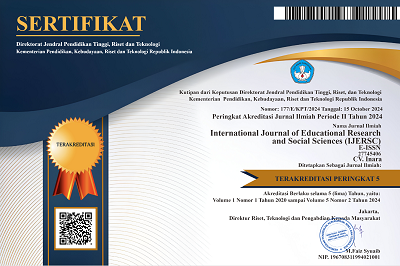Improving The Gross Motor Skills Of Mentally Retarded Children Through Rhythmic Brain Gym Activities
DOI:
10.51601/ijersc.v4i5.726Published:
2023-10-31Downloads
Abstract
This study aims to identify and describe the influence of Brain Gym or brain exercises to increase gross motor skills and fine motor mental reterdation category were aged 4 years to 6 years. In this study, the sample were students in kindergarten SLB Muhammadiyah Jombang. This study was conducted in 10 meetings for each child. Each child will be given the treatment in the form of brain exercise, starting from the lateral dimension, focusing dimension and the dimension of convergence. Tests performed every time the student has finished the movement brain gymnastics. This is done so that the results of tests that are obtained more accurately. Mental reterdation characteristics that have limitations in considering would negatively affect the test results. Tests for gross motor movement and fine motor movement using DDST test format. DDST contains procedures for conducting tests and evaluation of test results. For the tests of gross motor movement and fine motor movement there are three assessment criteria, namely failed, refused and passed. At the beginning of the meeting five tests carried out many items in the category of students failed and refused. This is caused by the adaptation of students in recognizing the new environment and the movement of brain exercises that they have never done before. At the end of the five meetings that the number of test items in the category refuse and fail to decline, it is because the students have started to adapt and understand instructions, instructions were given to them. Overall improvement of the results of tests on five initial meeting and five final meeting for categories of pass is 33.8%. Based on this research exercise influence Brain Gym on the development of gross motor movement and fine motor skills of children with intellectual challenges, it can be argued conclusions in this study are: Gymnastics Therapy Brain (Brain Gym) have an influence on the development of gross motor movement and fine motor movement for mental reterdation midle category were aged 4 years to 6 years.
References
A. Harahap, P. Hrp, N.K.A.R. Dewi, Macrozoobenthos diversity as anbioindicator of the water quality in the
River Kualuh Labuhanbatu Utara, International Journal of Scientific & Technology Research, 9(4), 2020, pp.
-183.
Harmon, Sandra. (2014). “Effects of Educational Kinesiology, Previous Performance,Gender, and
Socioeconomic Status on Phonological Awareness Literacy Screening Scores of Kindergarten Student”.
Educational Kinesiology Trust. Vol.07 No.5 .
Harahap, Arman ,2018, Macrozoobenthos diversity as bioindicator of water quality in the Bilah river,
Rantauprapat, Medan. J. Phys.: Conf. Ser. 1116 052026.
Safrida, S., Tannady, H., Solissa, E. M., Sapulete, H., & Al Haddar, G. (2023). Strategic Leadership Analysis of
School Principal to Improve Learning Quality. Jurnal Pendidikan dan Kewirausahaan, 11(2), 391-399.
Harahap, et, all, Macrozoobenthos diversity as anbioindicator of the water quality in the Sungai Kualuh
Labuhanbatu Utara, AACL Bioflux, 2022, Vol 15, Issue 6.
Harahap, Arman. 2020. Species Composition & Ecology Index Of The Family Gobiidae At The Mangrove
Belawan Of Sicanang Island International Journal of Scientific & Technology Research Volume 9, Issue 04,
April 2020.
Harahap, A., et all ( 2021), Monitoring Of Macroinvertebrates Along Streams Of Bilah River International
Journal of Conservation Sciencethis link is disabled, 12(1), pp. 247–258.
Hurlock, E.B. (1978). Perkembangan Anak Jilid I (Edisi Keenam). Jakarta: Erlangga.
Lubis, H., & Pratama, K., Safrida, S. (2022). HR related antecedes to sustainability reporting in Indonesian
public listed firm: The mediating role of employee committeemen. Cuadernos de Economía, 45(128), 87-97.
Hyatt,J.K.(2007).“Building Stronger Brains or Wishful Thinking”.Remidial and Special Educations.Vol.28
N0.02
Hyatt, J.K. (2009). “ A Review of Three Controversial Educational Practice: Perceptual Motor Programs,
Sensory Integration, and tinted Lenses”. Education and Treatment Of Children. Vol.32 No.2
Lutan, Rusli. (1988). Belajar Keterampilan Motorik, Pengantar Teori dan Metode. Jakarta: Depdikbud
PPLPTK.
Muhammad, As’adi. (2011). Dahsyatnya Senam Otak. Yogyakarta: Diva Press
International Journal of Educational Research & Social Sciences ISSN: 2774-5406
Magil, Ricard. 2001. “ Motor Learning Concep and Applications. Singapore: Lousiana State University.
Mamangkey, J., Suryanto, D., et all (2021). Isolation and enzyme bioprospection of bacteria associated to
Bruguiera cylindrica, a mangrove plant of North Sumatra, Indonesia, Biotechnology Reports, 2021, 30, e00617.
Nugroho, H.S.W. 2009. Petunjuk Praktis Denver Developmental Screening Test. Jakarta: Penerbit Buku
Kedokteran EGC.
Sarkum, S., Syamsuri, A. R., & Supriadi, S. (2020). The role of multi-actor engagement. Journal of Open
Innovation: Technology, Market, and Complexity, 6(4), 176.
Nursalim, Dkk. 2007. Psikologi Pendidikan. Surabaya : Unesa University Press
Spielman. 2005. “The effects of movement based learning on student achievement in the elementary school
classroom”. Educational Kinesiology Trust. Vol.07 No.3.
Supriadi, ., Dalimunthe, R. F., Lumbanraja, P., & Tarmizi, H. B. (2021). The Antecedent Of Educational Staff
Contextual Performance In Medan City Private Universities. Archives of Business Research, 9(2), 316–338.
https://doi.org/10.14738/abr.92.9817
Sugiyono. 2010. Metode Penelitian Pendidikan. Bandung: CV. Alfabeta.
Sugiyono. 2014. Memahami Penelitian Kualitatif. Bandung: CV. Alfabeta.
Sri, R., Mahdi, F., Julkarnain, J., Kurnia, H. N. T., & Habibie, A. (2022). Intellectual capital and islamic
corporate social responsibility on the financial performance of sharia commercial banks in Indonesia. In E3S
Web of Conferences (Vol. 339, p. 05003). EDP Sciences.
Tauchid, M.N, dan Noor, Zulkhah. 2009. “Pengaruh Senam Otak (Brain Gym) Terhadap Kualitas Tingkah Laku
Anak Autis Di Yogyakarta”. Jurnal Penelitian, Universitas Muhammadiyah Yogyakarta.
Tim Penyusun, 2014. Pedoman Penulisan Tesis dan Disertasi Program Pascasarjana Unesa. Surabaya: Unesa
Watson, A and Gingger L.K. (2014). “The Effect of Brain Gym® on Academic Engagement For Children With
Developmental Disabilities”. International Journal Of Spesial Education. Vol.29 No.02
Warron, Steve. (2006). “ Psychology in Mental Retardation and Developmental Dissabilies”. Amerian
Physychological Assosiation. Vol.32 No.3.
Kurnianingsih, H. T., & Rahayu, S. (2020). Financial Performance Assessed From Economic Value Edded
(EVA) and Market Value Added (MVA) Cases in the Cosmetics Sub-Sektor and Household Needs Listed On the
BEI. Budapest International Research and Critics Institute, 3(4), 3179-3184.
License
Copyright (c) 2023 International Journal of Educational Research and Social Sciences (IJERSC)

This work is licensed under a Creative Commons Attribution 4.0 International License.






